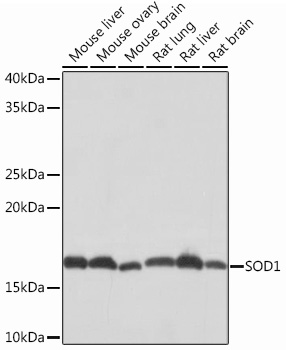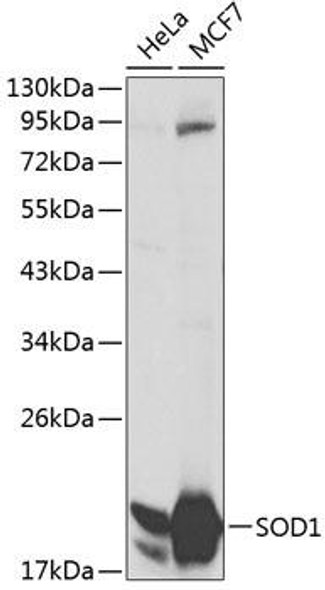Anti-SOD1 Antibody (CAB12537)
- SKU:
- CAB12537
- Product type:
- Antibody
- Reactivity:
- Human
- Mouse
- Rat
- Host Species:
- Rabbit
- Isotype:
- IgG
- Antibody Type:
- Monoclonal Antibody
- Research Area:
- Cell Biology
Description
| Antibody Name: | Anti-SOD1 Antibody |
| Antibody SKU: | CAB12537 |
| Antibody Size: | 20uL, 50uL, 100uL |
| Application: | WB |
| Reactivity: | Human, Mouse, Rat |
| Host Species: | Rabbit |
| Immunogen: | A synthesized peptide derived from human SOD1 |
| Application: | WB |
| Recommended Dilution: | WB 1:500 - 1:2000 |
| Reactivity: | Human, Mouse, Rat |
| Positive Samples: | HeLa, 293T, MCF7, Mouse liver, Mouse ovary, Mouse brain, Rat lung, Rat liver, Rat brain |
| Immunogen: | A synthesized peptide derived from human SOD1 |
| Purification Method: | Affinity purification |
| Storage Buffer: | Store at -20°C. Avoid freeze / thaw cycles. Buffer: PBS with 0.02% sodium azide, 0.05% BSA, 50% glycerol, pH7.3. |
| Isotype: | IgG |
| Sequence: | Email for sequence |
| Gene ID: | 6647 |
| Uniprot: | P00441 |
| Cellular Location: | |
| Calculated MW: | 18kDa |
| Observed MW: | 16KDa |
| Synonyms: | ALS, ALS1, HEL-S-44, IPOA, SOD, hSod1, homodimer |
| Background: | The protein encoded by this gene binds copper and zinc ions and is one of two isozymes responsible for destroying free superoxide radicals in the body. The encoded isozyme is a soluble cytoplasmic protein, acting as a homodimer to convert naturally-occuring but harmful superoxide radicals to molecular oxygen and hydrogen peroxide. The other isozyme is a mitochondrial protein. Mutations in this gene have been implicated as causes of familial amyotrophic lateral sclerosis. Rare transcript variants have been reported for this gene. [provided by RefSeq, Jul 2008] |
| UniProt Protein Function: | SOD1: Destroys radicals which are normally produced within the cells and which are toxic to biological systems. Homodimer; non-disulfide linked. Homodimerization may take place via the ditryptophan cross-link at Trp-33. The pathogenic variants ALS1 Arg-38, Arg-47, Arg-86 and Ala-94 interact with RNF19A, whereas wild-type protein does not. The pathogenic variants ALS1 Arg-86 and Ala-94 interact with MARCH5, whereas wild-type protein does not. Belongs to the Cu-Zn superoxide dismutase family. |
| UniProt Protein Details: | Protein type:Oxidoreductase; Mitochondrial; EC 1.15.1.1; Nuclear receptor co-regulator; Apoptosis Chromosomal Location of Human Ortholog: 21q22.11 Cellular Component: dendrite cytoplasm; extracellular space; protein complex; mitochondrion; extracellular region; mitochondrial intermembrane space; cytosol; nucleoplasm; extracellular matrix; cell soma; mitochondrial matrix; cytoplasm; plasma membrane; peroxisome; cytoplasmic vesicle; nucleus Molecular Function:identical protein binding; protein binding; protein homodimerization activity; copper ion binding; zinc ion binding; chaperone binding; superoxide dismutase activity; Rac GTPase binding; protein phosphatase 2B binding Biological Process: positive regulation of catalytic activity; activation of MAPK activity; positive regulation of apoptosis; cellular iron ion homeostasis; myeloid cell homeostasis; retrograde axon cargo transport; response to antibiotic; muscle maintenance; retinal homeostasis; glutathione metabolic process; regulation of mitochondrial membrane potential; neurofilament cytoskeleton organization and biogenesis; positive regulation of superoxide release; negative regulation of neuron apoptosis; placenta development; positive regulation of cytokine production; response to drug; platelet activation; cell aging; regulation of organ growth; transmission of nerve impulse; response to reactive oxygen species; response to ethanol; heart contraction; response to heat; superoxide release; relaxation of vascular smooth muscle; removal of superoxide radicals; locomotory behavior; response to organic substance; sensory perception of sound; platelet degranulation; ovarian follicle development; regulation of blood pressure; response to axon injury; auditory receptor cell stereocilium organization and biogenesis; anterograde axon cargo transport; negative regulation of cholesterol biosynthetic process; response to nutrient levels; response to superoxide; thymus development; regulation of T cell differentiation in the thymus; response to amphetamine; superoxide metabolic process; myelin maintenance in the peripheral nervous system; regulation of multicellular organism growth; response to hydrogen peroxide; response to copper ion; spermatogenesis; regulation of protein kinase activity; blood coagulation; embryo implantation; hydrogen peroxide biosynthetic process Disease: Amyotrophic Lateral Sclerosis 1 |
| NCBI Summary: | The protein encoded by this gene binds copper and zinc ions and is one of two isozymes responsible for destroying free superoxide radicals in the body. The encoded isozyme is a soluble cytoplasmic protein, acting as a homodimer to convert naturally-occuring but harmful superoxide radicals to molecular oxygen and hydrogen peroxide. The other isozyme is a mitochondrial protein. Mutations in this gene have been implicated as causes of familial amyotrophic lateral sclerosis. Rare transcript variants have been reported for this gene. [provided by RefSeq, Jul 2008] |
| UniProt Code: | P00441 |
| NCBI GenInfo Identifier: | 134611 |
| NCBI Gene ID: | 6647 |
| NCBI Accession: | P00441.2 |
| UniProt Related Accession: | P00441 |
| Molecular Weight: | |
| NCBI Full Name: | Superoxide dismutase |
| NCBI Synonym Full Names: | superoxide dismutase 1 |
| NCBI Official Symbol: | SOD1 |
| NCBI Official Synonym Symbols: | ALS; SOD; ALS1; IPOA; hSod1; HEL-S-44; homodimer |
| NCBI Protein Information: | superoxide dismutase [Cu-Zn] |
| UniProt Protein Name: | Superoxide dismutase [Cu-Zn] |
| UniProt Synonym Protein Names: | Superoxide dismutase 1; hSod1 |
| Protein Family: | Sodium channel |
| UniProt Gene Name: | SOD1 |
| UniProt Entry Name: | SODC_HUMAN |





